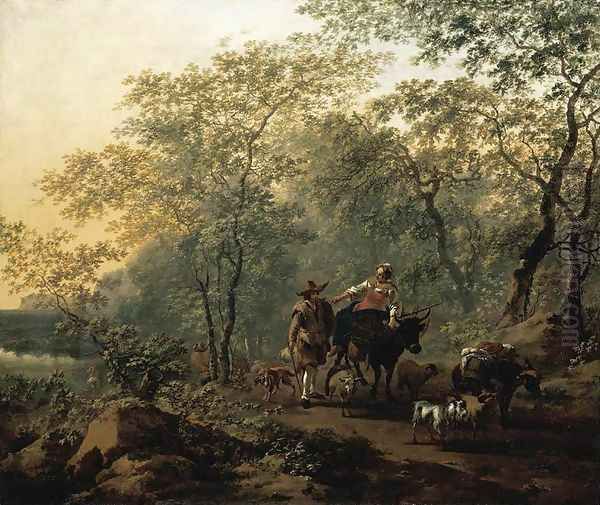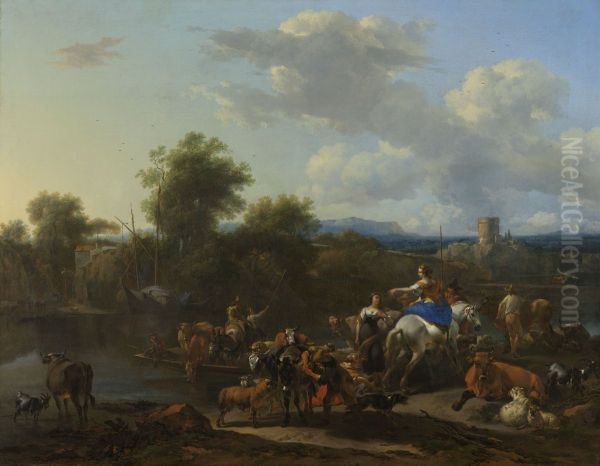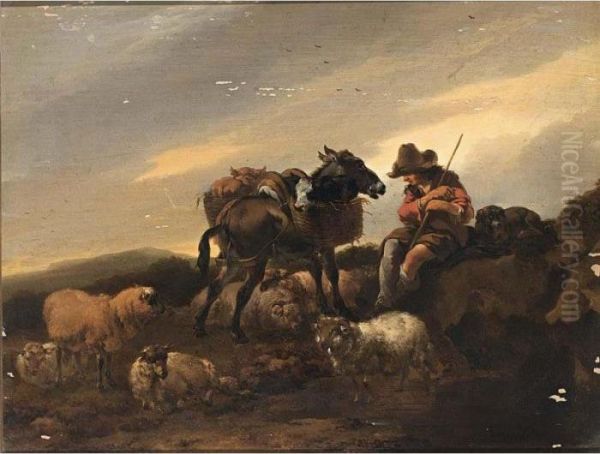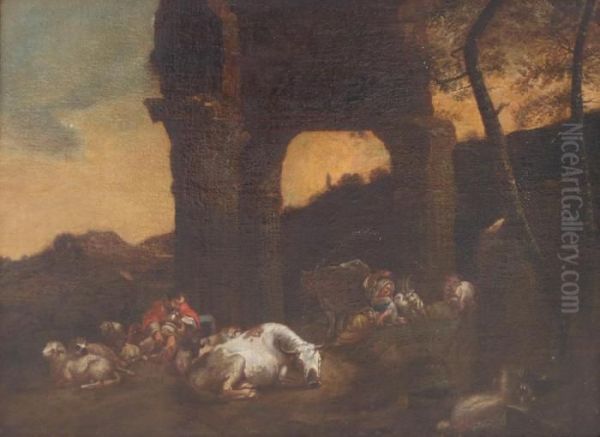
Nicolaes Pietersz. Berchem stands as one of the most celebrated and prolific artists of the Dutch Golden Age. Active during the vibrant 17th century, Berchem carved a unique niche for himself, becoming a leading figure in the Dutch Italianate landscape movement. His canvases, filled with sun-drenched pastoral scenes, idyllic shepherds, and evocative ruins, captured the imagination of his contemporaries and continue to enchant viewers today. His influence extended far beyond his painted works, reaching into the realms of etching and drawing, and shaping the tastes of artists and collectors across Europe for generations.
Early Life and Artistic Formation in Haarlem
Nicolaes Berchem was born in Haarlem, a bustling artistic center in the Netherlands, likely baptized on October 1, 1620. His artistic inclinations were perhaps inevitable, given his parentage. His father was Pieter Claesz., a highly respected master of the ontbijtje, or breakfast piece still life. While Nicolaes did not follow directly in his father's footsteps regarding subject matter, the meticulous attention to detail and texture evident in Pieter Claesz.'s work may have subtly informed the younger Berchem's own careful rendering of the natural world.
His initial training undoubtedly came from his father, but Nicolaes soon sought instruction from other prominent Haarlem masters to broaden his horizons, particularly in landscape painting. Sources suggest he studied with a succession of notable artists. Jan van Goyen, a pioneer of tonal landscape painting, likely imparted a sensitivity to atmosphere and light. Claes Cornelisz. Moeyaert (also referred to as Cornelis Coeijt Moeyaert), known for his historical and biblical scenes often set in landscapes, may have encouraged Berchem's integration of figures and narrative elements. Other potential teachers mentioned include Pieter de Grebber, Jan Wils, and possibly Nicolaes Moyaert's relative, Jan Baptist Weenix.

An amusing, though perhaps apocryphal, anecdote recorded by the art historian Arnold Houbraken attempts to explain the origin of his name, "Berchem." According to the story, the young Nicolaes was once fleeing his father's anger when his fellow pupils urged his pursuers to "Berg hem! Berg hem!" meaning "Save him! Save him!" Whether true or not, the story hints at a lively apprenticeship and adds a touch of human drama to his early years. By 1642, his training was sufficiently advanced for him to be accepted into the Haarlem Guild of Saint Luke, the professional organization for painters and craftsmen, marking his official entry into the artistic profession.
The Allure of Italy: Journeys and the Italianate Style
The mid-17th century saw a significant trend among Dutch artists: the journey to Italy. The warm light, classical ruins, and picturesque countryside of the Italian peninsula held an immense fascination for artists from the often-greyer climes of the Netherlands. These journeys profoundly impacted their work, leading to the development of the "Dutch Italianate" style, characterized by idealized landscapes bathed in a golden, Mediterranean glow, often populated by peasants, shepherds, and livestock.
Whether Nicolaes Berchem actually made the full journey south to Italy remains a subject of some scholarly debate. However, the overwhelming evidence in his artwork strongly suggests either direct experience or intensive study of Italian scenes and the work of artists who had been there. Some accounts propose an early trip, perhaps in the 1640s, possibly accompanying his relative (perhaps cousin) Jan Baptist Weenix, himself a prominent Italianate painter.
A more documented journey occurred around 1650. Berchem traveled with fellow Haarlem landscape painter Jacob van Ruisdael, one of the giants of Dutch landscape art. Their destination was the region around Bentheim, near the Dutch-German border. The sketches and paintings resulting from this trip show close collaboration and shared artistic interests. It's possible that Berchem continued southward towards Italy after this excursion, perhaps between 1650 and 1653. He would have absorbed the works of earlier Dutch Italianates like Pieter van Laer (nicknamed "Il Bamboccio"), Jan Both, and Jan Asselijn, who specialized in depicting Roman street life and the Italian Campagna.
Regardless of the exact travel itinerary, the spirit of Italy permeates Berchem's most characteristic works. He masterfully captured the warmth of the southern sun, contrasting bright, illuminated areas with cool, deep shadows. His landscapes often feature rolling hills, distant blue mountains, classical ruins hinting at a glorious past, and rustic buildings. These settings form the backdrop for his favoured subjects: shepherds tending their flocks, peasants resting or traveling with their animals, and lively scenes near rivers or ports.
Themes, Techniques, and Representative Works

Nicolaes Berchem was exceptionally versatile. While best known for his Italianate landscapes, his oeuvre encompasses a broader range of subjects and moods. His core, however, remained the pastoral idyll. He depicted a harmonious vision of rural life, where humans and animals coexist peacefully within a beautiful, often idealized, natural setting.
His technical skill was considerable. Berchem possessed a fluid brushstroke and a keen eye for detail. He rendered the textures of foliage, rocks, animal hides, and fabrics with convincing realism. His compositions are typically well-balanced, often using diagonal lines created by paths, rivers, or hillsides to lead the viewer's eye into the scene. He masterfully employed light not just for illumination but also to create mood and atmosphere, often favouring the warm, golden light of early morning or late afternoon.
Figures and animals – the "staffage" – are integral to his landscapes, never mere afterthoughts. Berchem was highly skilled at painting lively, expressive figures and a wide variety of animals, particularly cattle, sheep, goats, donkeys, and dogs. His ability in this area was so respected that he was frequently commissioned by other landscape painters, including Jacob van Ruisdael, Meindert Hobbema, and Jan Hackaert, to add figures and animals to their own canvases, thereby enhancing their appeal and value.
Beyond the purely pastoral, Berchem explored mythological and biblical themes, often setting these narratives within his characteristic Italianate landscapes. The Infant Zeus with the Nymphs on Mount Ida (c. 1650) is a prime example, blending classical mythology with a lush, detailed natural setting populated by goats and nymphs under a warm sky. He also painted allegorical scenes and occasionally winter landscapes or scenes closer to his native Holland, such as The City Wall of Haarlem, showcasing his adaptability.
Among his most representative and celebrated works are:
Italian Landscape: A quintessential example showcasing his mastery of light, composition, and the idealized Italian countryside. Several paintings bear this or similar titles.
The Cattle Herd: Demonstrates his skill in depicting livestock within a luminous landscape setting.
The Cattle Ferry: A lively scene combining landscape, figures, and animals in a dynamic composition.
Resting Herd (c. 1652): An etching that highlights his skill in printmaking and his focus on pastoral themes.
Three Resting Cows: A focused study showcasing his intimate knowledge of animal anatomy and behaviour.
Rocky Landscape with Ancient Ruins (Felsensatz mit antiken Ruinen): Emphasizes the picturesque combination of nature and classical remnants.

The Three Droves: Another example of his popular cattle-themed landscapes.
His output was prodigious, with estimates suggesting around 850 paintings, alongside numerous drawings and etchings. This vast body of work cemented his reputation as a tireless and imaginative artist.
A Master Etcher and Draughtsman
Berchem's talents were not confined to oil painting. He was also a highly accomplished etcher and draughtsman. He produced at least 57 etchings, primarily focusing on animal subjects and pastoral scenes. These prints were executed with remarkable freedom and sensitivity, capturing light and texture with the same skill evident in his paintings.
His etchings proved immensely popular and were widely circulated, collected, and copied. They served as models for other artists and craftsmen, significantly contributing to the dissemination of his style. Art historian Gerdien Wustman noted that the sheer volume of prints generated after Berchem's designs was "almost unrivalled," indicating their widespread appeal and influence. His drawings, often preparatory studies for paintings or standalone works, further reveal his keen observational skills and fluid handling of line. These prints and drawings were crucial in establishing and maintaining Berchem's fame across Europe, particularly in France during the 18th century. They were even used as decorative motifs on items like Dutch porcelain.
Collaborations, Influence, and Recognition
Throughout his career, Berchem interacted with many leading artists of his time. His collaboration with Jacob van Ruisdael on the Bentheim journey is well-documented. His relationship with Jan Baptist Weenix, whether as cousin, travel companion, or collaborator (perhaps on works like The Calling of St. Matthew, though specific joint works can be hard to pinpoint definitively), was also significant.
His training under figures like Jan van Goyen and Cornelis Claesz. Moeyaert, and his potential studies with Pieter de Grebber, shaped his early development. His mature style shows an awareness of, and dialogue with, the work of fellow Italianate painters like Jan Both, Jan Asselijn, and Pieter van Laer. His own father, Pieter Claesz., though a still-life painter, provided his foundational artistic environment.

Berchem's influence extended significantly into the 18th century. French Rococo artists, in particular, admired the elegance, charm, and picturesque qualities of his work. Painters like Jean-Baptiste Pillement directly borrowed motifs and stylistic elements from Berchem. Antoine Watteau and Thomas Gainsborough are also known to have studied and copied his works, drawn to his graceful compositions and delicate rendering of nature and figures.
During his lifetime and throughout the 18th century, Berchem was one of the most highly esteemed and sought-after Dutch painters. His works commanded high prices, and his inclusion in a collection signified sophisticated taste. His paintings were particularly popular among French and British collectors.
Personal Life and Later Years
In 1646, Nicolaes Berchem married Catharina Claesdr de Groot in Haarlem. Like the anecdote about his name, stories about his married life, primarily from Houbraken, paint a colourful picture. Catharina is often described as being avaricious and keeping a tight rein on her husband's finances, supposedly forcing him to work relentlessly and collecting his earnings immediately. While potentially exaggerated, these accounts suggest the domestic realities that might underpin an artist's prolific output. The couple had children, though details about them, including whether sons followed him into painting professionally (a Nicolaes Berchem the Younger is sometimes mentioned, but his significance is unclear), are sparse.
Berchem seems to have spent most of his working life in Haarlem but moved to Amsterdam sometime around 1677, perhaps seeking new patrons or opportunities in the larger metropolis. He continued to paint productively into his later years. Nicolaes Berchem died in Amsterdam on February 18, 1683, and was buried in the city's famous Westerkerk, the final resting place of Rembrandt van Rijn decades earlier.
Legacy and Enduring Appeal
Nicolaes Berchem's legacy is multifaceted. He was a pivotal figure in the Dutch Italianate landscape tradition, masterfully blending northern European observational detail with southern European light and idealism. His vision of a harmonious, sunlit pastoral world resonated deeply with the tastes of his time and influenced subsequent generations of artists, particularly those associated with the Rococo movement.
His reputation experienced fluctuations. While immensely popular in the 17th and 18th centuries, his idealized style fell somewhat out of favour during the 19th century with the rise of Realism and more naturalistic landscape approaches. However, modern art history has re-evaluated his contribution, recognizing his technical brilliance, his versatility, and his significant role within the rich tapestry of Dutch Golden Age art.

Today, his works are held in major museums worldwide, including the Rijksmuseum in Amsterdam, the Louvre in Paris, the National Gallery in London, the Wallace Collection in London, the Hermitage Museum in St. Petersburg, and many others. His paintings, drawings, and etchings continue to be studied and admired for their technical finesse, their atmospheric beauty, and their enduring depiction of an idyllic world bathed in golden light. Nicolaes Berchem remains a testament to the skill, imagination, and international outlook of Dutch artists during their Golden Age.